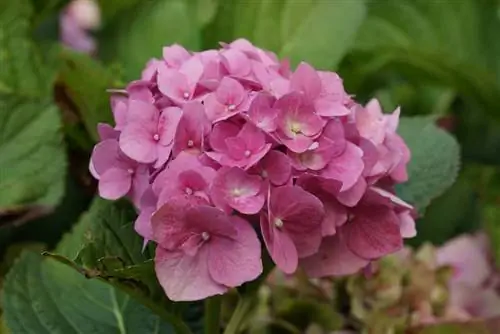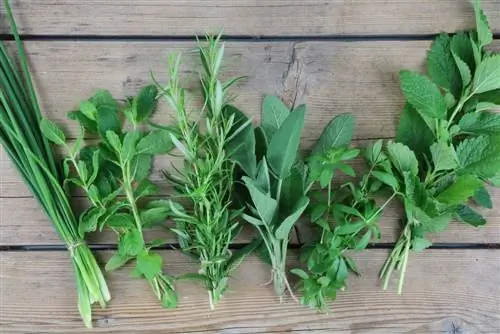- Author admin [email protected].
- Public 2023-12-17 03:39.
- Last modified 2025-01-24 12:45.
Hydrangeas are one of the few acid-loving plants that thrive best in soils that would kill most other plants. In addition to suitable soil conditions, nutrients are of course also important. Providing additional nutrients in the form of homemade fertilizer supports the plant's ability to produce deep blue to purple-red flowers. The color depends primarily on the pH value of the soil, which is why the hydrangea changes its flower color from blue to pink when fertilized with lime. For this reason, hydrangea growers usually use an acidic fertilizer for their plants.
Nutrients
Just because a plant prefers a highly acidic soil pH does not mean that the hydrangea needs different nutrients than a plant growing in calcareous soil. A hydrangea still needs around 13 elements to thrive he althily, just like all other plants. The only difference is that hydrangeas cannot absorb these nutrients without an acidic environment. A hydrangea should preferably be fertilized with a nitrogen-based fertilizer that contains little phosphorus. Special hydrangea fertilizers are available from specialist retailers, but alternatively all fertilizers for azaleas or rhododendrons can be used, as the plants have similar requirements as hydrangeas. Most universal fertilizers for flowering plants have too high a phosphate content for hydrangeas and are therefore less suitable. High amounts of phosphate in the soil cause blue-flowering hydrangeas to bloom pink again because the aluminum responsible for the blue color can no longer be absorbed.
Basic mix for fertilizer
1. Nutrient suppliers
If you make your own fertilizer for hydrangeas, you should use materials that provide sufficient quantities of the nutrients that hydrangeas need. Of course, suitable ready-made fertilizers for hydrangeas can be purchased from the garden center. But this is not absolutely necessary, because anyone who owns a garden actually already has everything they need to produce suitable fertilizer for hydrangeas. These materials are available free of charge, and some of them are even waste products. Others can be made quickly and with little effort.
Good nutrient suppliers for hydrangeas include:
- worm soil (the excreta of earthworms or compost worms)
- Algae products (e.g. fished algae from the garden pond)
- crushed pine bark
- Alfalfa flour
- Compost
In combination with well-ripened, crumbly compost, this mixture will provide the hydrangeas with all the nutrients they need while the soil still remains acidic.
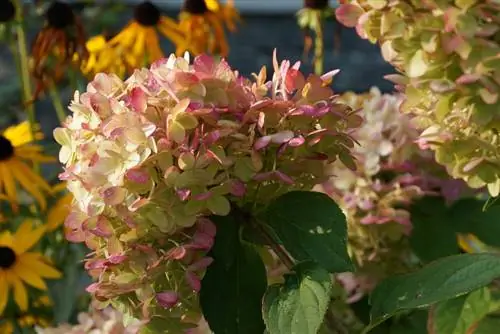
2. Additives for an optimal pH value
In nature, hydrangeas prefer to grow on peaty heathland or in moorland areas. What all of these areas have in common is that the soil has a very low pH value. Normal garden soils generally cannot offer these conditions. Normal soils are only slightly acidic (around 6-6.5), very clayey or clayey soils are even alkaline. For this reason, in almost all gardens, a fertilizer mix for hydrangeas must be naturally acidic. If the pH value is already optimal, additional acidic fertilizers are in most cases completely unproblematic. A few hydrangea species prefer an alkaline soil, and the acidifying component should be avoided when fertilizing them.
Acid materials for fertilizer:
- Peat
- peat moss
- Fir needles or spruce needles
- crushed conifer bark
- Coffee grounds (also reacts slightly acidically)
Alkaline materials for fertilizer:
- Ashes from the grill or fireplace
- Lime
Flower colors at different pH values
Some varieties of hydrangeas have the ability to bloom blue if the soil conditions are right. The pH value in the soil is primarily responsible for this. These include garden hydrangeas (Hydrangea macrophylla), also known as farmer's hydrangeas, Japanese hydrangeas or potted hydrangeas.
- blue flowers: pH value below 5.5 (4.0 to 4.5 is optimal)
- pink flowers: pH value above 6.5
- At pH levels between 5.5 and 6.5, these hydrangeas produce purple flowers
Tip:
If you enjoy it, you can change the color of your hydrangeas every year.
Blue color
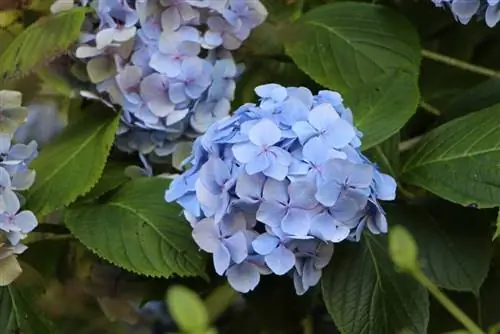
Blue hydrangeas often bloom pink over time. This doesn't have to be the case, because with a little expertise, hydrangeas can continue to bloom blue. Pink hydrangeas can also be dyed blue (again). However, pure white or red hydrangeas - no matter what the gardener does - always remain white or red. They are not suitable for recoloring. On the one hand, the pH value in the soil is important for the formation of blue flowers. Blue hydrangeas absolutely require a highly acidic soil with a pH between 4.0 and 4.5. A trace element is ultimately responsible for the blue color: aluminum. This must also be present in sufficient quantities in the soil. So if the pH value is correct, but the hydrangea continues to bloom pink, it is lacking aluminum. This can be supplied to the hydrangea with a s alt called alum (potassium aluminum sulfate), which is available at the pharmacy or is listed in the garden center under hydrangea blue. Fertilizers for blue hydrangeas should always contain a small amount of alum. For each fertilization, around one to two tablespoons of the s alt are mixed with the fertilizer and incorporated into the garden soil, ideally in spring. If a blue hydrangea is already blooming pink, it can take up to two years for it to change color again. So a little patience is required. Larger amounts of alum do not shorten the time but only harm the hydrangea.
Iron against chlorosis
Hydrangeas often suffer from the deficiency symptom chlorosis. Chlorosis can be recognized by the yellow leaf veins and the yellowing of young leaves. This coloring is due to a lack of the trace element iron. There are two reasons for iron deficiency. On the one hand, there is simply not enough iron in the soil. Secondly, there may be enough iron, but the plant just cannot absorb it. This is always the case when the pH value in the substrate is too high. From a pH value above 5.5, the iron is in a water-insoluble form, so that it is no longer absorbed by the plant. The countermeasures are extremely simple. In the first case, only a small amount of iron (iron chelate fertilizer) needs to be mixed into the fertilizer. In the second case, acidic fertilizer helps.
Special blend
If you don't have all the components in your own garden, you can also buy individual materials commercially. You can then use these products for other acid-loving plants at the same time. A good homemade hydrangea fertilizer contains the following components:
- Basic component: mature compost
- Seaweed products, crushed
- Peat (alternatively peat moss, conifer bark, pine or pine needles)
- complexed iron (chelated iron) or iron sulfate in traces
- Alfalfa flour, also called alfalfa flour (high nitrogen content and low phosphorus)
- small amounts of Epsom s alt
- Horn shavings or horn meal (about 12-15% N, but less than 1% P)
- Alum for blue hydrangeas
Fertilize
Since this fertilizer is a purely organic fertilizer, the nutrients are released very slowly. Therefore, in contrast to mineral fertilizers, a significantly larger amount of fertilizer is necessary. The fertilizer can be mixed into the hydrangeas' soil in handfuls in spring and again in May or June. For potted plants, it is recommended to add fertilizer when repotting them annually. Hydrangeas in small pots are better served with a liquid fertilizer.
Liquid fertilizer for potted plants
If the hydrangea is in a pot on the balcony or terrace, when it is repotted in spring, a good portion of the special mixture described above is mixed into the soil. The second fertilization is done with a liquid fertilizer that you also make yourself. Since the fertilizer smells somewhat unpleasant, it is not suitable for houseplants. The homemade hydrangea fertilizer in liquid form consists of:
- 10 liter bucket
- Water
- Compost (about 3 liters)
- Peat to lower the pH value
In an old bucket, mix the compost with a little water. If you want to lower the pH value, add one to two handfuls of peat or peat moss and fill the bucket with water. Leave covered in a warm place for at least 24 hours. Meanwhile, stir several times. You can then sieve out the solid components. Before use, the compost extract should be diluted with plain water until it is the color of weak tea. For quick absorption, the fertilizer can be sprayed onto the leaves with a flower sprayer, and some is also applied to the roots as irrigation water.
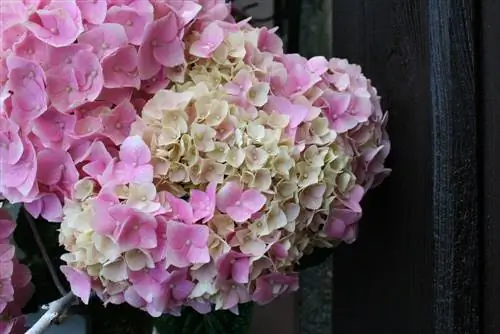
Conclusion
A good hydrangea fertilizer is quick and easy to make yourself. What is particularly important is that the soil pH value is lowered via acidic components in the fertilizer. Most hydrangeas prefer a very acidic soil with a pH value of 4 to 4.5. Blue hydrangea varieties in particular require a very low pH value in addition to aluminum to develop the blue color.
Tips for speed readers
- blue hydrangeas need acidic soil
- from pH 5.5 and above the flower becomes increasingly red
- incorporate acidic components into the fertilizer (to lower the pH value)
- peat, peat moss or conifer leaves are suitable for this
- Compost is a good source of nutrients
- Hydrangeas require high nitrogen and low phosphorus levels
- add algae or horn shavings for additional nutrients
- worm castings and alfalfa meal are also good
- do not use mineral fertilizers
- Iron against chlorosis
- Aluminum s alts (alum) to form the blue flower color
- Liquid fertilizer for potted plants
- Prepare broth from compost, water and peat (for acidic soil)
- Let stand for 24 hours, strain and dilute
- spray on leaves and pour on roots

